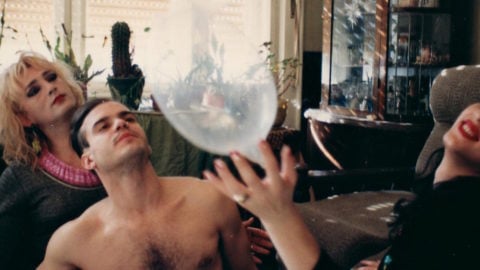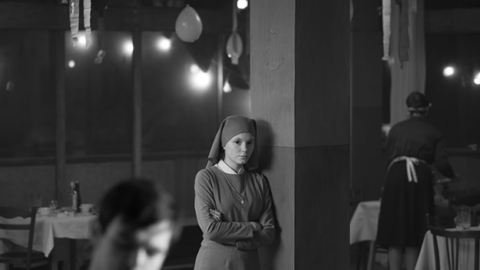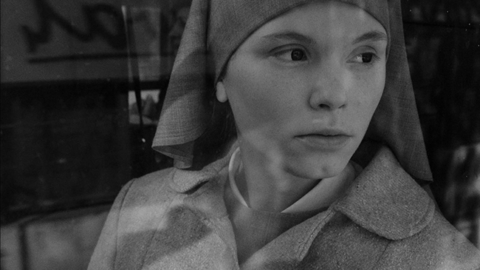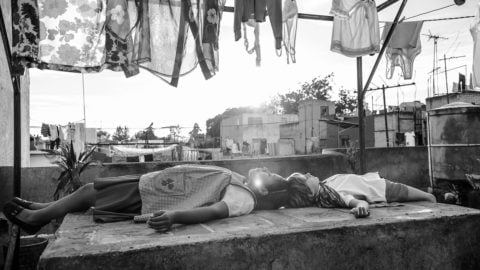Blues for the Iron Curtain: Cold War and Red Boogie
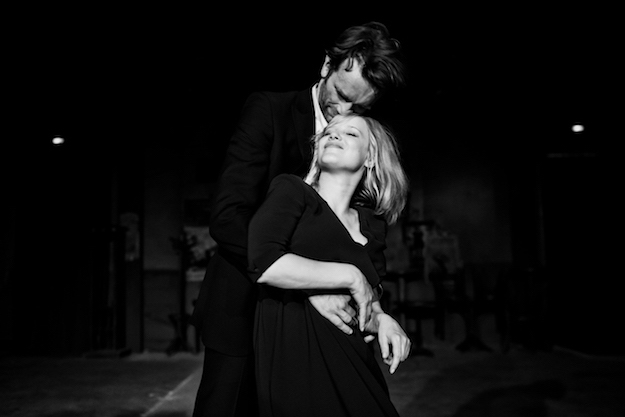
Cold War
“Culture is our weapon,” a communist government functionary declares in Red Boogie, Karpo Godina’s ebullient, satirical 1982 film about a jazz-loving band in 1950s Slovenia on an enforced, morale-boosting tour of the provinces. When the movie screened at the Museum of Modern Art in October as part of a series devoted to Godina, the theme of music and traditional culture being coopted for totalitarian propaganda recalled Paweł Pawlikowski’s superb new film Cold War, which played in the 56th New York Film Festival earlier the same month. In both films, women sing folk songs done over as slow-burn jazz, and both use a patchwork of different musical styles to evoke the turbulent historical currents their characters must navigate—from folk melodies to French chansons, from big-band swing to brass-band marches, from Billie Holiday to Bill Haley.
Cold War opens and closes in rural Poland, where a ruined church stands open to the sky, faceless eyes gazing from the fragments of a fresco on the wall. There is something in this image of incompleteness and loss that haunts the film, whose characters seem afflicted as much by some inner refusal of happiness and fulfilment as by the forces of political repression. The story begins in 1949, following a small group of folklorists traveling around the countryside recording music played by weather-beaten peasants in tiny villages buried in snow and lost in time. The group opens a school of folk dance and music in a dilapidated rural estate, holding auditions for students. These early scenes are enchanting, explaining nothing but casting a spell with the sharp, sweet, wild sound of close-harmony a cappellasinging and the swooping, leaping, foot-stomping energy of Slavic folk dance. Like Pawlikowski’s 2014 Academy Award winner Ida, Cold War is shot (by cinematographer Łukasz Żal) in glistening, razor-sharp black-and-white that draws stark contrasts between lucid northern light and shadowy interiors, and directed in a refreshingly old-fashioned style of deliberate, sensuously austere compositions.
During the school’s tryouts, a sultry blonde student (Joanna Kulig) catches the eye of pianist Wiktor Warski (Tomasz Kot), one of the directors. The girl, Zuzanna, known as Zula, is tough and calculating; she is on probation for stabbing her stepfather (“he mistook me for my mother,” she explains), and after they become lovers, she admits to Wiktor that she has been reporting on him to a government minder. The school has already been ordered to harness folk culture to communist propaganda, and soon it becomes a slick state-sponsored troupe performing in front of a gigantic portrait of Stalin. On tour in East Berlin in 1952, Wiktor defects to the West, while Zula inexplicably stands him up and stays behind. They keep separating and reuniting over the years, moving between Paris and Warsaw, between nasty fights and torrid sex, between authenticity and artistic compromise. Their story is filled with ellipses, skipping large chunks of time and major events, never really explaining why Zula keeps leaving, or why Wiktor, despite repeatedly calling her “the love of my life,” often treats her contemptuously. The relationship (apparently based loosely on the director’s parents) is never heavy-handedly allegorical, but its ambivalent tangle of yearning, need, and rejection is a clear-eyed portrait of the reality of exile, the experience of living between worlds and not being able to settle in either. The homeland exerts a pull despite its impossible conditions, and the refuge (even the ideal of bohemian Paris) somehow leaves the expatriates hollow and unsatisfied.
The passage of time and the changing worlds through which the lovers move are richly evoked: the dark, smoky Parisian jazz clubs, nocturnal city streets, recording studios, opulent national theaters and threadbare apartments are atmospheric without ever making you conscious—as so many films set in the past do—of set-dressing and period details. The aging of the characters is likewise free of false notes; Joanna Kulig, in particular, brilliantly inhabits Zula’s transformations, her frequent changes of hairstyle and look matching her insecure, impulsive character. Throughout the film, the most expressive and moving scenes are those where music and dance take over. One of the only moments in which the lovers seem truly, simply happy together comes when they are dancing, sloppily and sexily, in an empty wee-hours nightclub. If Wiktor’s character never emerges strongly, Zula’s is sharply delineated in performances, from the vulnerable purity of her singing in her audition to her ecstatic dance in a nightclub to “Rock Around the Clock,” to her tragically trashy final number—overweight, drunk, in a dark wig, backed by musicians in sombreros. The corruption and exploitation of culture underlines the sadness of the film’s trajectory, and in the end the couple seems to grasp at some lost authenticity, rootedness and permanence, albeit with a final gesture of romantic futility. This cold war like the global one hinges on mutually assured destruction.
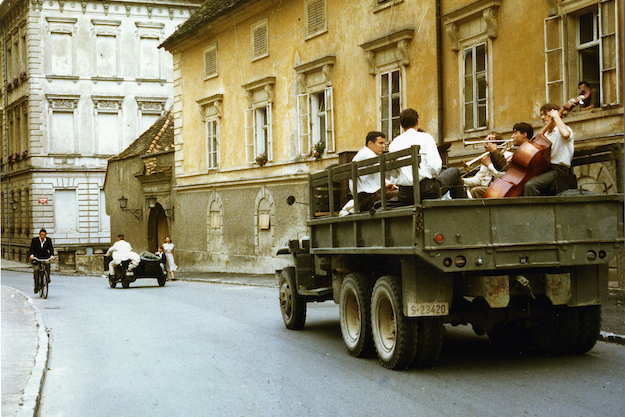
Red Boogie
Red Boogie (Rdeči Boogie) tells its story almost entirely through music. The movie opens with a clip from the 1944 Esther Williams vehicle Bathing Beauty, with trumpeter Harry James playing some scalding boogie-woogie as girls in hot-pink bathing suits execute a synchronized aqua-ballet in a vast turquoise swimming pool. This film is being shown to students as an example of decadent and debauched capitalism, as becomes clear from audience heckling (“That’s not for proletarians!” and “Down with scrofulous Hollywood!”). A scuffle breaks out in the theater between outraged young ideologues and those who simply want to look at girls in bathing suits, the brawl spilling out into the rainy streets of Ljubljana. This opening sets a playful, mocking tone carried through most of the film, which combines humor at the expense of humorless politics with exuberant delight in the pleasures of jazz and freedom. The young musicians are incorrigible, playing the blues and swing they love despite visits from secret police in black leather trenchcoats. Led by the flirtatious charmer Jozef (Jozef Roposa) and the more serious and openly defiant Peter (Peter Mlakar), whose father is a political prisoner, the band is reluctantly hauled off on a tour of the countryside, under the hapless and bumbling command of government stooge Jan (Ivo Ban), and accompanied by the suave, ironic Maks (Boris Cavazza), who projects propaganda films showing cheerful workers on state-sponsored trips to the seaside.
Riding around in the back of an open pickup truck through misty fields and muddy farms, the city boys are alternately amused and horrified witnesses to the Socialist Federal Republic of Yugoslavia’s efforts to cram socialism down people’s throats. Some scenes suggest that the worst of communism is how uncool it is: after watching a rousing newsreel urging farmers to do their patriotic duty in eradicating the potato beetle (an invader from America, the film-within-a-film emphasizes), the band has to play upbeat polkas while the villagers examine their crops for pests. But they also see farmers publicly punished and bullied for such crimes as hiding cows from the state, and a morose villager shooting himself in a dreary provincial tavern. There is no plot per se, just a serious of episodes, but every scene is engaging. The band hooks up with Milena (Ursula Rebek), a pretty young singer who shares their gift for sly rebellion, performing a jazz version of a Slovenian folk song; kicking up her heels with kooky abandon when they play forbidden swing music; and discomfiting the square Jan by asking him to draw stocking-seams on the backs of her legs.
Director, cinematographer, editor, and screenwriter, the Slovenian-Macedonian Karpo Godina emerged as a member of the Black Wave movement in 1960s Yugoslavia, a group of filmmakers seeking greater freedom both in political expression and stylistic experimentation. While Red Boogie is formally free-wheeling, its viewpoint is much more straightforward than Cold War’s retrospective ambivalence. It pits individual freedom against authoritarian repression, and like Pawlikowski’s film it waits until the end to reveal just how brutally far totalitarian regimes will go to control their people. All Red Boogie’s jokes about potato beetles and sousaphones give way to something deeper when Peter is killed trying to flee across the border. The scene is set in a gorgeous coastal landscape of hills covered in yellow flowers, but the mellow color suddenly switches to black and white in a coda that merges the characters with the grainy newsreels that have punctuated the film. Jozef and Milena’s jazzy performance of a folk song unfurls over footage of the proletarian masses happily paddling in the surf like children—an ironic echo of the synchronized swimmers in the Technicolor opening. It is a mysterious vision of grace and harmony floating free from the story, carried by music that lingers after the image is gone.
Imogen Sara Smith is the author of In Lonely Places: Film Noir Beyond the City and Buster Keaton: The Persistence of Comedy, and has written for The Criterion Collection and elsewhere. Phantom Light is her regular column for Film Comment.



